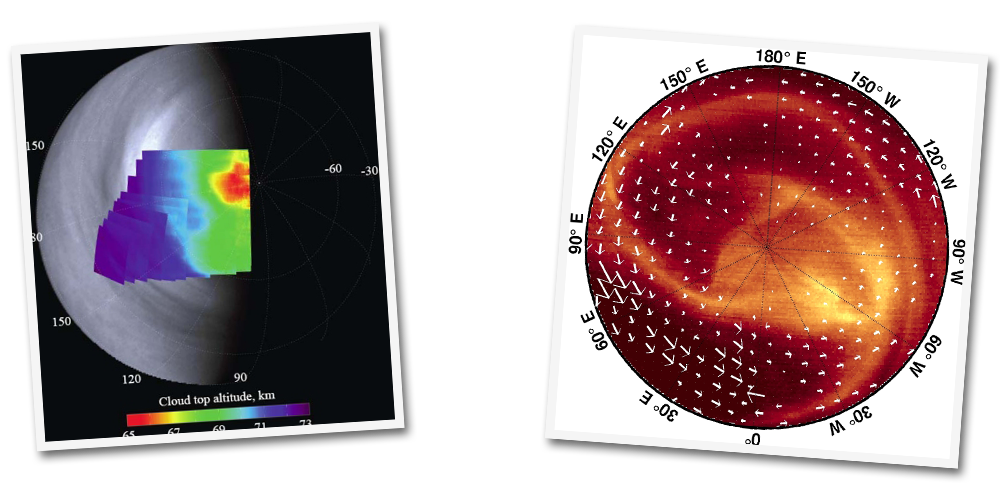OUTPUTS


PROJECT REPORTS
• Agendas and steering committee reports are available at the Meetings page.
RAW DATA PRODUCTS:
• Data from Venus Express are publically available at ESA's Planetary Science Archive (PSA). Tools and documentation about how to access and download the datasets can be found on that website, here: http://www.rssd.esa.int/PSA/.
HIGHER LEVEL DATA PRODUCTS:
• VEx/SOIR: The ESA PSA as detailed above contains Level 2 (raw spectra) and Level 3 (calibrated spectra). Vertical profiles of CO2 density and temperatures from the SPICAV-SOIR (Solar Occultation in the InfraRed) experiment are publically available upon registration from the Belgian Institute of Space Aeronomy webpage here: http://venus.aeronomie.be/en/soir/soir_data.htm. The website includes documentation, and observation database and tools for accessing the data..
• VEx/VeRa: The ESA PSA as detailed above contains Level 1 (raw) and Level 2 (calibrated Doppler frequency residuals) for the Venus Express Radio Science experiment. Higher Level 4 (individual profiles of neutral density, pressure and temperature) and Level 5 (binned by latitude and Local Solar Time regions) data will be made publically available upon registration from the University of Cologne's web server here: http://www.radio-science.eu/?page_id=746&lang=en. Data currently available here include Level 5 binned data; Level 4 profiles will delivered by Oct 2016.
• VEx/VIRTIS: The ESA PSA as detailed above contains Level 2 (radiances in Data Numbers) and Level 3 (radiances calibrated in scientific units) data. As part of the EuroVenus research, wind vectors are being obtained on the basis of feature tracking from VIRTIS data. Data will be released both in the form of 2D vector fields, as well as latitude profiles of 2D wind velocities. These products will be made available on a web server at the University of Lisbon, accessible either directly or via the Europlanet Virtual Observatory system (http://vespa.obspm.fr/).
• 2012 Venus transit observations and derived products: Raw data for EuroVenus research of the transit was available from three observatories:
- Hinode satellite, raw data publically available from http://sdc.uio.no/sdc/welcome;
- Solar Dynamics Observatory, raw data publically available from http://jsoc.stanford.edu/; and
- Venus Twilight Experiment, http://venustex.oca.eu/, raw data to be published in Q2 2016.
Higher level data, that is to say vertical profiles of temperature and aerosol abundances, will be published at the http://venustex.oca.eu website once the publication describing their analysis has completed the peer review process (Q2 2016).
• VEx/VeRa: The ESA PSA as detailed above contains Level 1 (raw) and Level 2 (calibrated Doppler frequency residuals) for the Venus Express Radio Science experiment. Higher Level 4 (individual profiles of neutral density, pressure and temperature) and Level 5 (binned by latitude and Local Solar Time regions) data will be made publically available upon registration from the University of Cologne's web server here: http://www.radio-science.eu/?page_id=746&lang=en. Data currently available here include Level 5 binned data; Level 4 profiles will delivered by Oct 2016.
• VEx/VIRTIS: The ESA PSA as detailed above contains Level 2 (radiances in Data Numbers) and Level 3 (radiances calibrated in scientific units) data. As part of the EuroVenus research, wind vectors are being obtained on the basis of feature tracking from VIRTIS data. Data will be released both in the form of 2D vector fields, as well as latitude profiles of 2D wind velocities. These products will be made available on a web server at the University of Lisbon, accessible either directly or via the Europlanet Virtual Observatory system (http://vespa.obspm.fr/).
• 2012 Venus transit observations and derived products: Raw data for EuroVenus research of the transit was available from three observatories:
- Hinode satellite, raw data publically available from http://sdc.uio.no/sdc/welcome;
- Solar Dynamics Observatory, raw data publically available from http://jsoc.stanford.edu/; and
- Venus Twilight Experiment, http://venustex.oca.eu/, raw data to be published in Q2 2016.
Higher level data, that is to say vertical profiles of temperature and aerosol abundances, will be published at the http://venustex.oca.eu website once the publication describing their analysis has completed the peer review process (Q2 2016).

